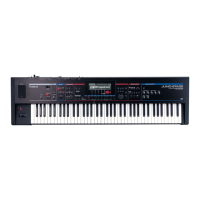38
Chapter 1. Overview
Broadly speaking, the JUNO STAGE consists of a controller section, a
sound generator section, and a song player section.
fig.BasicStruct-e
Controller Section
This section consists of a keyboard, pitch bend/modulation lever, the
panel buttons and knobs, D Beam controller, and pedals connected to
the rear panel. The performance information generated when you
press/release a key or press a hold pedal are transmitted as MIDI
messages to the sound generator section and/or an external MIDI
device.
Sound Generator Section
This section produces the sound. It receives MIDI messages from the
controller section, song player section, or an external MIDI device,
generates musical sound according to the MIDI messages that were
received, and outputs the sound from the output jacks and headphone
jack.
Song Player Section
The Song Player is used to play back audio files or SMF data saved in
USB memory.
It can also play rhythm patterns in a variety of styles.
You can play along on the keyboard accompanied by the song or
rhythm pattern played by the Song Player.
When using the JUNO-STAGE’s Song Player to play songs, you can
create a “playlist” to specify the order in which songs will play. To
create playlists, you need to use the included “Playlist Editor.” For
details, refer to “Using JUNO-STAGE Editor/Librarian/Playlist Editor”
(p. 93).
When using the JUNO-STAGE as a MIDI sound module, you can use
it in either Performance mode or in Patch mode.
Patch Mode
In Patch mode you can use a connected keyboard or other device to
play a single Patch on the JUNO-STAGE. Since Patch mode lets you
use a variety of effects on a single patch, you can play very rich
textures.
In Patch mode it’s also easy to edit the selected sound, so this is the
mode to use when editing or creating your own sounds.
Performance Mode
In Performance mode you can use multiple patches or rhythm sets
simultaneously. A performance contains sixteen “Parts.” You can
assign a patch or rhythm set to each part, and use them as an
ensemble, or layer sounds to create rich textures.
Of the sixteen parts in a Performance on the JUNO-STAGE, part 1 is
assigned to “UPPER” and part 2 is assigned to “LOWER” (p. 51).
With the factory settings, Patch mode is selected.
How a Performance is Structured
A performance has a patch or rhythm set assigned to each of the 16
parts, and can simultaneously handle 16 sounds.
Because the JUNO-STAGE sound generator can control multiple
sounds (instruments) it is called a Multi-timbral sound generator.
Part
A “part” is something to which you assign a patch or rhythm set. In
Performance mode, each performance has sixteen parts, and you can
assign a patch or rhythm set to each part.
How the JUNO-STAGE is Organized
Basic Structure
Sound Generator
Section
Playback
Song Player Section
Play
Rhythm Pattern
Song Player
Controller Section
(controllers such as keyboard, pitch bend/modulation lever, etc.)
Patch Mode and Performance Mode
Performance
Part 16
Part 1
Patch/
Rhythm Set
JUNO-STAGE_e.book 38 ページ 2008年10月17日 金曜日 午後12時27分

